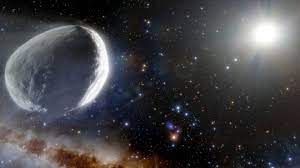Bernardinelli-Bernstein Comet:

The National Aeronautics and Space Administration’s (NASA) Hubble Space Telescope has confirmed that the huge Bernardinelli-Bernstein comet is indeed the largest icy comet nucleus ever seen by astronomers.
- The nucleus is called the C/2014 UN271 which has an estimated diameter of almost 129 kilometres.
- The nucleus is around 50 times larger than that of most known comets, and its mass is estimated to be around 500 trillion tonnes.
- Bernardinelli-Berstein Comet was discovered by astronomers Pedro Bernardinelli and Gary Bernstein in archival images from the Dark Energy Survey at an astronomical observatory in Chile.
- It was discovered in November 2010 and has been intensively studied since.
- The comet has been travelling towards the sun for over a million years and it is believed to have originated in the Oort Cloud.
- Oort Cloud is a distant region of the solar system that is predicted to be the source of most comets.
- The Oort Cloud is still only a theoretical concept as the comets that constitute it are too faint and distant to be directly observed.
- It was first hypothesised by Dutch astronomer Jan Oort in 1950.
- The Bernardinelli-Berstein comet follows a 3-million-year-long elliptical orbit and has an estimated temperature of minus 348 degrees Fahrenheit.
- It is warm enough to sublimate carbon monoxide (CO) from the surface to produce the dusty coma.
Hubble Space Telescope:
- It was launched by NASA in 1990 and is named in honour of Edwin Hubble, a revered American astronomer of the early 20th century.
- The telescope is a space-based observatory and has made significant observations related to interstellar objects, including moons around Pluto and a comet crashing into Jupiter.
- The telescope has now been in operation for over thirty years.
- In December 2021, NASA’s James Webb Space Telescope, a revolutionary instrument built to peer the farthest yet into the cosmos, was launched.
- It is also considered a successor of the Hubble Telescope and will extend and complement its discoveries.




